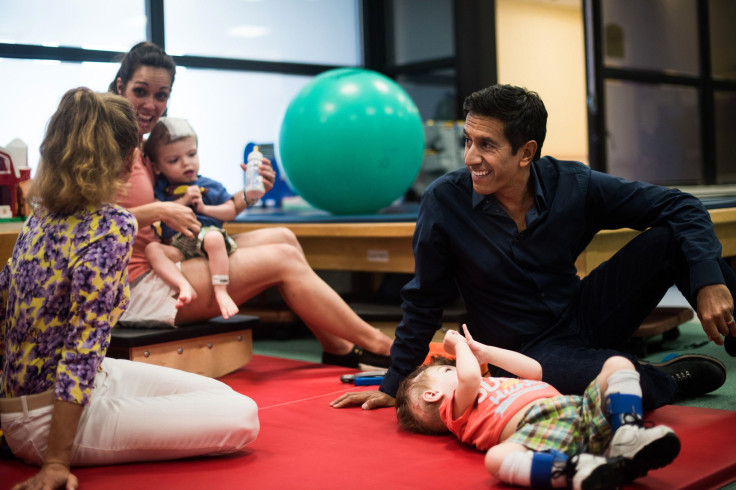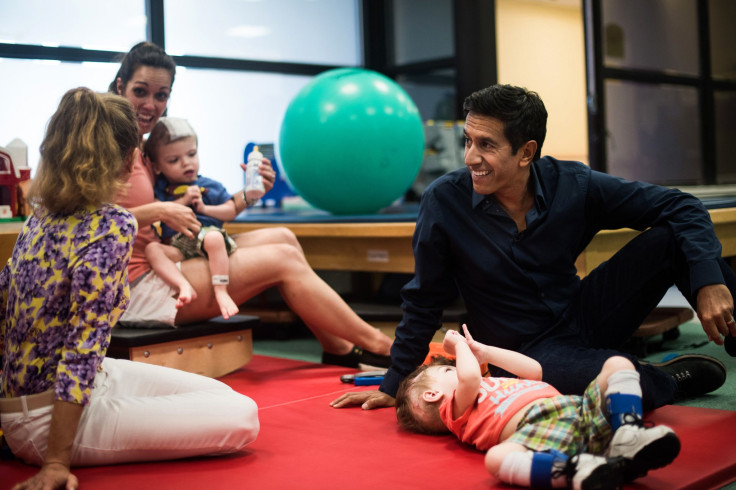Conjoined McDonald Twins Update: What Surgeons Said About Separating Babies

From the moment they were born until the time they were 13-months old, twins Jadon and Anias McDonald never spent a moment apart. The boys were born the rarest of rare: Only one in 2.5 million sets of twins are craniopagus, or conjoined at the head. In merely surviving, the twins had defied the odds. Forty percent of such twins are stillborn, while one-third die within the first 24 hours after birth. But Jadon and Anias made it — forcing their parents Nicole and Christian McDonald to decide whether to separate the boys.
That decision led them to the operating room at the Children’s Hospital at Montefiore in the Bronx, New York, where on Oct. 13, 2016, a team of more than 30 medical professionals led by pediatric neurosurgeon Dr. James Goodrich would spend 27 hours in an attempt to give Anias and Jadon a shot at having independent lives.
Read: Conjoined McDonald Twins Post-Surgery Photos Show Road To Recovery
The preparation for the surgery began long before the operating room doors opened. The team met with Anias and Jadon’s parents in January 2016 — even before meeting the boys to exchange perspectives and review the situation. From then on, Goodrich and the rest of the specialists mapped out potential issues, carefully analyzing everything and anything that could go wrong once the surgery was underway.
“The one thing we knew, which was certainly amplified here, was to expect the unknown,” Dr. Oren Tepper, the director of craniofacial and aesthetic surgery programs at Montefiore and the lead plastic surgeon on the team, told International Business Times. “When you do face those issues, you know they’re coming. You don’t know what they are, but you know they’re coming.”

The separation surgery was Goodrich’s seventh, none of which have been similar or uncomplicated.
“We’ve never been given an easy case where it’s just conjoined bones and skin,” Goodrich told IBT. “All of these kids have had pretty significant anatomy issues and none of them have been the same.”
Read: How Doctors Choose Which Conjoined Twin To Save
In the case of Jadon and Anias, the challenge for Goodrich came in the midst of the surgery when it became apparent that one of the twins was much more significantly conjoined than the pre-surgery MRIs suggested. Goodrich had to face the possibility that one or both of the boys might not make it through the surgery and was forced to decide whether to proceed or stop. With the help of all the specialists on the team, Goodrich ultimately decided to continue.
“The anatomy of the veins had changed pretty dramatically,” said Goodrich. “Making the decision to bite the bullet and go through with it was very complex. If you lose control of the bleeding, it can be very fast, very profuse and it can be lethal.”
Twenty-seven hours and four stages of surgery later, the boys had, for the first time ever, two distinct bodies. Jadon, however, fared better during the surgery, while Anias required additional procedures after his heart rate and blood pressure dropped significantly during the operation.
“I brought Jadon upstairs, and I don’t know if the parents had thought or envisioned not seeing both boys together,” said Tepper. “It was this moment of obvious joy for the family, but still, the anxiety of knowing Anias was still in the operating room.”
Nicole McDonald was finally able to hold Jadon four days after the surgery when he finally awoke. Having always been connected to Anias before then, it was the first time the mother had ever held her son. She recalled to CNN’s Sanjay Gupta that holding Jadon alone was “one of the most profound moments” of her life.
“As a mother you know, when you hold your child, you know every bit of their face,” she recalled. “Well his face also encompassed Anias’. So it was my first moment of relearning his face.”
“You don’t realize, and I’ve been through this now a number of times, the psychological impact of parents with conjoined twins, of seeing them separate,” Goodrich told IBT. “I’ve only experienced it as a surgeon but in each and every case when parents see them apart in separate beds it’s an enormously emotional moment.”
After the boys left Montefiore, they were taken to a rehabilitation facility at Blythedale Children’s Hospital in Valhalla, New York, where their journey was just beginning. Goodrich explained that in the case of conjoined twins, one child always emerges as the more dominant twin, as is evident in the boys’ recovery.
“Once you’re separated, you’re basically back to infancy at birth,” he told IBT. “You have no head control. You haven’t learned how to sit up or stand, or certainly how to walk. In this case, Jadon, who has been the stronger of the two, has really sailed.”
Goodrich said Jadon had reached the point where he was ready to begin walking.
“Anias has been slower,” Goodrich said. “His motor control is behind his brother but there’s really no reason he shouldn’t be able to catch up.”
Tepper recalled his visit to the boys on Wednesday to check in on their progress.
“I saw both boys yesterday,” Tepper told IBT. “One of the uncertainties is what kind of motor movement they would have. We expected some motor weakness on one side of the boys, but Jadon was sitting up eating. He wasn’t favoring one hand, he was using both.”
“That’s the beauty of plasticity in really young children,” said Goodrich. “They are really doing extremely well.”
CNN’s “Separated: Saving the Twins” will air Jun. 23, 2017 at 10 p.m. EST.
© Copyright IBTimes 2024. All rights reserved.






















